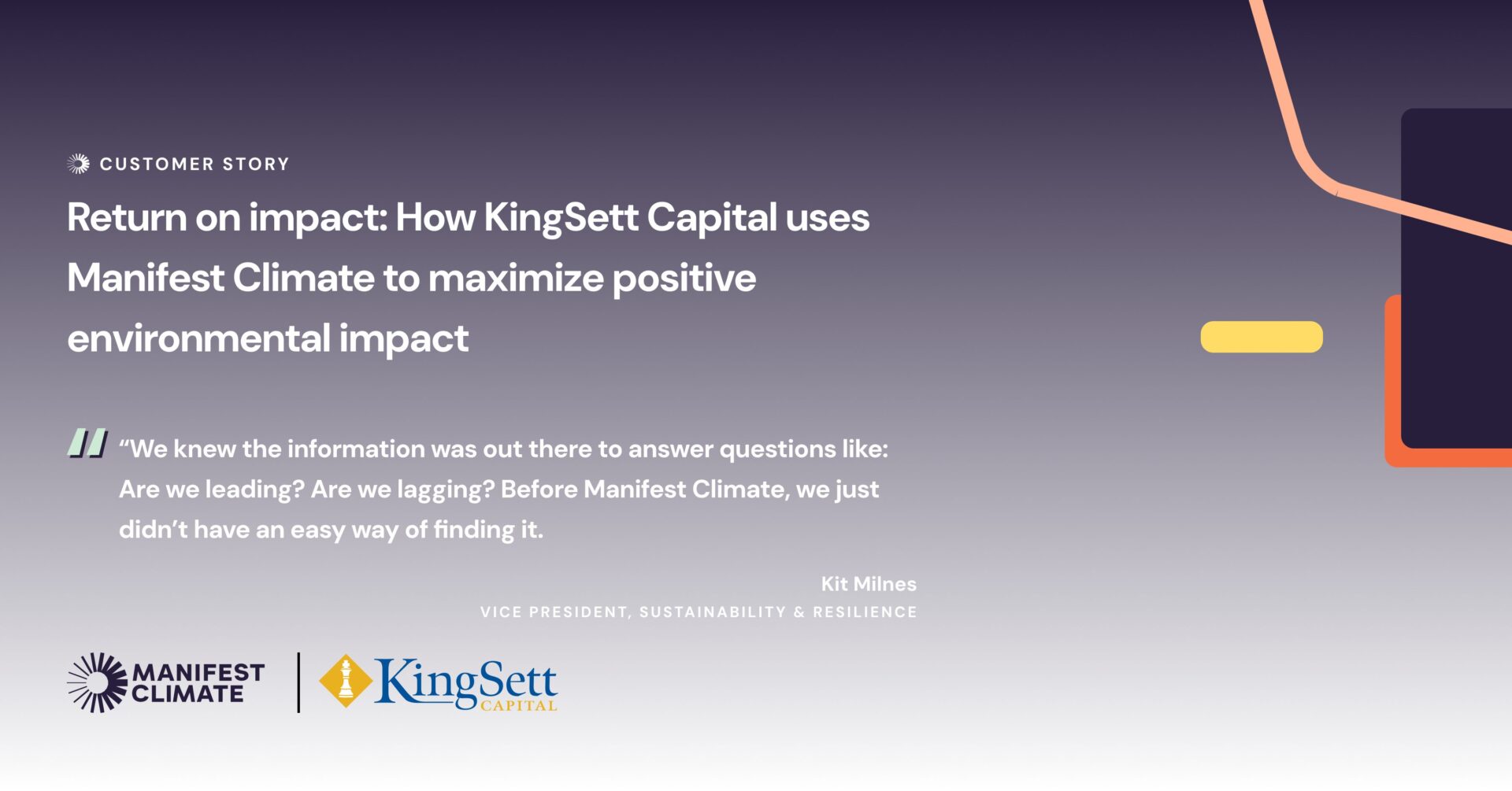KingSett Capital is a private equity real estate investment firm in Canada. Its $18 billion in assets is funded by its own capital, alongside that from institutional investors and ultra-high-net-worth individuals. KingSett’s real estate asset classes include office, retail, industrial, multi-family, hotels and developments. KingSett also creates bespoke financing solutions for a wide range of projects and properties including construction and term financing across all asset classes with more than $5 billion of loan commitments across Canada. With investor returns as the long-term goal, the company turned its focus to climate risk.
We spoke to Kit Milnes, the Vice President of Sustainability & Resilience, who is responsible for sustainable investing, decarbonization, and resilience programming. In recent years, his focus has been on embedding sustainability and ESG into the company’s business functions by not simply setting targets and strategies, but also determining what external financing (incentives, rebates, government loans, etc.) might be available to help the company move its ESG progress forward.
“We’re responsible for figuring out how to meet the financial return our investors are expecting, while also maximizing the positive impact for every dollar we invest,” Milnes explains.
To achieve their sustainability goals, KingSett leverages Manifest Climate to conduct detailed peer and industry benchmarking, understand the evolving regulatory landscape, and inform ESG programming.
How would you describe Manifest Climate?
It’s probably the most sophisticated benchmarking tool in the market. It allows you to quickly and accurately identify opportunities and risks across your portfolio, based on where your industry and others are going.
Kit Milnes, Vice President, Sustainability & Resilience at KingSett Capital
Benchmarking against peers
What led KingSett to Manifest Climate was how difficult it proved to get good benchmarking data. “There’s no real ability to get a proper industry benchmark on how you’re performing outside of GRESB,” says Milnes. Finding Manifest Climate allowed KingSett to benchmark themselves against the information their peers were disclosing publicly. Trying to do this exercise in-house was particularly time-consuming, and the team found they could not get insightful or actionable data. “After spending hours and hours on it, you don’t even know what the takeaway is or if any value came of it,” Milnes explains.
With Manifest Climate, a company can see not only how you score against peers, but also how you score against international and mandatory reporting standards. “Having a platform that provides this digitally, in a live environment, as companies release new information, provided immense value for the team,” says Milnes, who believes the value Manifest Climate provides will only grow with time.
Providing context
The ability to benchmark against industry peers gives KingSett the context and detail it needs to approach its sustainability and impact targets and strategy. “We really wanted to understand where others were at,” says Milnes, “but we couldn’t get that clarity through something like GRESB; it just doesn’t provide that level of detail.” The team knew that there was valuable information hidden in the pages and pages of sustainability reports from their peers. “We knew the information was out there to answer questions like: Are we leading? Are we lagging? Who’s setting targets? What are they setting targets for? Why? Before Manifest Climate, we just didn’t have an easy way of finding it,” Milnes explains.
Saving time
Because it would take hours to read through sustainability reports manually, Manifest Climate provides insights that the team simply could not get otherwise. “We’re a very small team,” says Milnes. “I don’t have the time in the day to do this type of underlying research and analysis. It could take hundreds of hours if you want to do it in-depth and create actual value out of it.”
We talk frequently about how Manifest Climate saves teams time. It does, but this framing often obscures the real issue, which is that, without a platform like Manifest Climate, these kinds of detailed benchmarking exercises simply couldn’t be performed at all, because most sustainability teams simply don’t have the time and resources to do it. For many of our customers, our software does not simply reduce the time it takes to complete existing activities; it gives them the capacity to undertake new activities that would not be possible without the time-condensing properties of our AI-powered proprietary methodology.
“I’ve been doing these reports for over a decade,” says Milnes, “and I rarely, if ever, read someone else’s report from start to finish. Getting my own report out is enough work, so having access to a platform that navigates directly to the valuable information is hugely valuable. If you feel like you need more, you can keep reading within that section.”
From benchmarking to climate action
KingSett’s benchmarking exercises don’t just help the team justify their sustainability strategies with investors — they also directly inform the company’s programming and validation. “It really helps us determine: Do we move forward and create a program or initiative for this? How far do we go with it?” explains Milnes. “Or, if we’re recognized as an industry leader on a particular program, are others following? Or are we out there on our own?” Getting answers quickly to these questions allows the team to evolve their strategies in real time.
Manifest Climate also helps KingSett to get clarity on what’s happening externally and, as a result, prioritize where they should focus internally. “I think it’s really helping us understand this messy, massive market,” says Milnes. “If you let the market drive you, you’re going to be spread so thin because it’s going to tell you to do everything, everywhere, all at once.”
Global climate risk management
Climate risk management is becoming increasingly complex, with numerous voluntary and mandatory standards taking shape across different regions and jurisdictions. “What sold us on Manifest Climate was the portfolio-level climate resilience assessment,” says Milnes. This broad view allowed the team to get a “good high-level overview of all the regions we’re invested in and what big risks we should be thinking about when opportunities to mitigate those risks arise,” Milnes explains.

